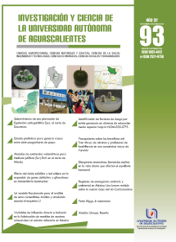Endocrine disruptors: Substances hidden in daily life that affect hormonal balance
DOI:
https://doi.org/10.33064/iycuaa2024935042Keywords:
Endocrine system, endocrine disruptors, hormonal effects, endocrine diseases, common disruptorsAbstract
The endocrine system (ES) is responsible for the proper functioning of the body by controlling metabolism, reproduction, growth, and mood. It comprises organs such as the pituitary gland, thyroid, parathyroid, pineal gland, and adrenals, which, together with other cells in other organs, regulate physiological functions by secreting hormones. However, the functioning of the ES can be altered by factors such as age, environment, stress, genetics, and some substances we are exposed to (called endocrine disruptors, ED). EDs are present in a wide range of products such as cosmetics, foods, personal products, textiles, etc. Exposure to these substances can cause serious endocrine damage and have adverse effects on health in the long term.
Downloads
References
• Bergman, Å., Heindel, J. J., Jobling, S., Kidd, K., Zoeller, T. R., & World Health Organization. (2013). State of the science of endocrine disrupting chemicals 2012. World Health Organization. DOI: https://doi.org/10.1016/j.toxlet.2012.03.020
• Caldwell, J. C. (2012). DEHP: Genotoxicity and potential carcinogenic mechanisms—A review. Mutation Research/Reviews in Mutation Research, 751(2), 82-157. DOI: https://doi.org/10.1016/j.mrrev.2012.03.001
• Carlos de Prada (2016). Los ftalatos. Un problema de salud pública que debe ser abordado con urgencia para proteger a mujeres embarazadas y niños. Ed. Hogar sin tóxicos. Madrid, España.
• Chichizola, C., Scaglia, H., Franconi, C., Ludueña, B., Mastandrea, C., & Pelayo, A. G. (2009). Disruptores endócrinos y el sistema reproductivo. Bioquímica y Patología Clínica, 73(3), 9-23.
• Criswell, R., Crawford, K. A., Bucinca, H., & Romano, M. E. (2020). Endocrine-disrupting chemicals and breastfeeding duration: a review. Current Opinion in Endocrinology, Diabetes and Obesity, 27(6), 388-395. DOI: https://doi.org/10.1097/MED.0000000000000577
• EPA. (2024). Overview of Endocrine Disruption, https://www.epa.gov/endocrine-disruption/overview-endocrine-disruption. Consultado: 11 de septiembre de 2024.
• García, J. M. M. (2001). Enfermedades del sistema endocrino y de la nutrición (Vol. 72). Universidad de Salamanca.
• IOMC (2012). State of the Science of Endocrine Disupting chemicals. https://wedocs.unep.org/bitstream/handle/20.500.11822/12223/EDCSP.pdf?sequence=5&isAllowed=y
• Jian, J. M., Guo, Y., Zeng, L., Liang-Ying, L., Lu, X., Wang, F., & Zeng, E. Y. (2017). Global distribution of perfluorochemicals (PFCs) in potential human exposure source–a review. Environment international, 108, 51-62. DOI: https://doi.org/10.1016/j.envint.2017.07.024
• Juan-García, A., Gallego, C., & Font, G. (2015). Toxicidad del Bisfenol A: Revisión. Revista de toxicología, 32(2), 144-160.
• Lindstrom, A. B., Strynar, M. J., & Libelo, E. L. (2011). Polyfluorinated compounds: past, present, and future. Environmental science & technology, 45(19), 7954-7961. DOI: https://doi.org/10.1021/es2011622
• Marieb, E. N. (2008). Anatomía y fisiología humana. Novena Edición, Universitario, 24.
• Menezes, R. G., Qadir, T. F., Moin, A., Fatima, H., Hussain, S. A., Madadin, M., Bilal Pasha, S. Rubaish, F. A. & Senthilkumaran, S. (2017). Endosulfan poisoning: An overview. Journal of forensic and legal medicine, 51, 27-33. DOI: https://doi.org/10.1016/j.jflm.2017.07.008
• OMS (2023). Las dioxinas. https://www.who.int/es/news-room/fact-sheets/detail/dioxins-and-their-effects-on-human-health#:~:text=Las%20dioxinas%20son%20muy%20tóxicas,no%20afectan%20a%20su%20salud. Consultado el 11 de septiembre de 2024.
• Perng W., Cantoral, A., Soria‐Contreras, D. C., Betanzos‐Robledo, L., Kordas, K., Liu, Y., Mora, A. M., Corvalan, C., Pereira, A., Augusto Cardoso, M., Chavarro, J. E., Breton, C. V., Meeker, J. D., Harley, K. G., Eskenazi, B., Peterson, K. E., Téllez-Rojo, M. M. (2021). Exposición a químicos disruptores endócrinos obesogénicos y obesidad en niños y jóvenes de origen latino o hispano en Estados Unidos y Latinoamérica: una perspectiva del curso de la vida. DOI: 10.1111/obr.13352. DOI: https://doi.org/10.1111/obr.13352
• Pombo, M., Castro, L., Barreiro, J., & Cabanas, P. (2020). A review on endocrine disruptors and their possible impact on human health. Rev Esp Endocrinol Pediatr [Internet], 11(2), 33-53.
• Rafi, S. M., Hazrami, Z. S. S. A. J., Nayeem, M., Richard, R. M., Alurkar, S. R. A., & Korrapati, N. H. (2024). Understanding parabens–A literature review. Cosmoderma, 4. DOI: https://doi.org/10.25259/CSDM_241_2023
• Rivas Velasco, A., Granada, A., Jimenez, M., Olea Serrano, F., & Olea Serrano, N. (2004). Exposición humana a disruptores endocrinos. Ecosistemas, Vol. 13, n. 3 (sept.-dic. 2004); pp. 7-12.
• Rodríguez, L. L. B., Salazar, C. C., & Ronderos, C. F. (2024). Disruptores endocrinos y enfermedades endocrinológicas en niños y adolescentes. Revista Colombiana de Endocrinología, Diabetes & Metabolismo, 11(2). DOI: https://doi.org/10.53853/encr.11.2.872
• Rolfo, A., Nuzzo, A. M., De Amicis, R., Moretti, L., Bertoli, S., & Leone, A. (2020). Fetal–maternal exposure to endocrine disruptors: Correlation with diet intake and pregnancy outcomes. Nutrients, 12(6), 1744. DOI: https://doi.org/10.3390/nu12061744
• Rueda Llata, B. (2024). Biología funcional de la glándula tiroides. Hiper e hipotiroidismo. Tesis de Licenciatura. Universidad de Cantabria, Facultad de Medicina.
• Secretaría de Salud. (2012). NOM-047-SSA1-2011. Salud ambiental-Índices biológicos de exposición para el personal ocupacionalmente expuesto a sustancias químicas (Fecha de consulta: 11 de septiembre de 2024).
• Secretaría del Trabajo y Previsión Social. (2024). NOM-003-STPS-2023, Actividades agrícolas-Condiciones de seguridad y salud en el trabajo (Fecha de consulta: 11 de septiembre de 2024).
• Young, W. F. Jr. (2022). Glándulas endocrinas, Manual MSD.
Downloads
Published
How to Cite
License
Copyright (c) 2024 Etnia Valeria Mora-Vargas, Sandra Loera-Serna

This work is licensed under a Creative Commons Attribution-NonCommercial-ShareAlike 4.0 International License.
Las obras publicadas en versión electrónica de la revista están bajo la licencia Creative Commons Atribución-NoComercial-CompartirIgual 4.0 Internacional (CC BY-NC-SA 4.0)









